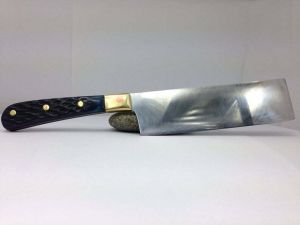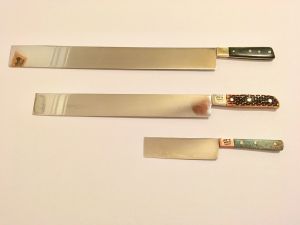The Shechitah Knife
From Halachipedia
What Can Be Used for Shechitah
- Technically, anything that is detached from the ground and sharp can be used for kosher slaughter, as long as it's free of imperfections. A reed membrane would be good if it doesn't have any splinters that would come out. Practically, however, this is exclusively done with a knife.[1]
- One shouldn't use a scythe or even a double edged knife if one side of it is a scythe. Bediavad if he did it and knows he used the kosher side, it's ok, and if he smoothened out the scythe side then he can use it lechatechilah.[2]
Pegimot
- A knife with a pegima (nick) may not be used. Bediavad, if one used it and claims he didn't use that part of the blade, the meat is kosher, but if he didn't realize it was there until afterwards, he has no claim.[3]
- Ideally even if one covers the pegimah, he might accidentally use the part with the pegimah.[4]
- If the blade has two edges, one must make sure both are free of pegimot.[5]
- On Yom Tov or in pressing circumstances, one can cover the pegima and shecht carefully, avoiding the pegimah, as long as there are two neck widths of length left of the knife from the pegimah in either direction and one shechts in a sawing motion. Some say the length is measured from the end of the cloth and not the pegimah. All this applies for two pegimot with enough blade length in between, as well.[6]
Crafting a Shechitah Knife
Modern day shechitah knives are commonly rectangularly shaped to facilitate shechitah without issues of chaladah and derasa.
- One should use a knife that ends in a right angle, not a sharp point, in order to avoid chaladah. In pressing circumstances, can can cover the tip with something light and then shecht (a hard tip cover could lead to derasa).[7]
- Some say the top of the knife should also be void of pegimot,[8] in case one ends up cutting with the top, while others note how the rectangular knives we use today avoid this issue.[9]
Sharpening a Shechitah Knife
Sharpening a knife is done by grinding the edge against coarse and then fine whetstones, back and forth, one side and then the other, until the knife is sharp and smooth.
Checking a Shechitah Knife
Guides
- Esek Hashechita by Rabbi Dovid Shaffier. See SeforimChatter Review here. (Book)
- Laevi Sussman's Video Guide (Video)
- IBC Experiential Halacha: Basics of Shechita-Knife Sharpening (Audio)
- Guide to Sharpening a Shechita Knife by Rabbi Avraham Moshe (PDF)

